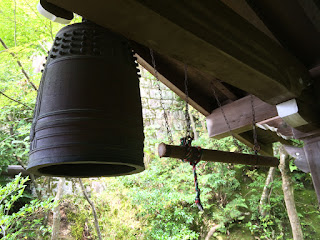My plans for any large scale projects in the garden have all been on hold this summer, the results of having to deal with the septic tank and leach field issues (new grass starting to fill in, but weeds a major issue) and my travels to Japan to visit gardens in Kyoto (postings to come later).
Now that both of those issues are in the past, I have been able to make some adjustments within the garden that I think will improve the design and views.
I decided that I did not like the look of the Boulevard Cypress Oriental Pompon (Chamaecyparis pisifera "Cyano-virdis') that I had planted in the are at the end of the East Gate stroll area last fall.
When I had designed the layout, I had always intended that spot for a dwarf Japanese maple (although I almost acquired a nice dwarf pine). However, I was to cheap to buy one last year and settled on the Oriental Pompom (it was on sale and very cheap at the time I purchased it). This summer I was able to find a Red Select Japanese Maple (Acer palmate dissect 'Red Select') that was on sale.
So, I removed the Pompom and replaced it with the Maple. In time the Maple should fill in this area very well.
I then moved the Pompom to within the garden, in the location with the Tachidōrō (or Kasuga-dōrō), or pedestal lantern.
The lantern had shifted significantly as a result of not having used gravel as a base when I first placed the lantern. However, I have been disappointed with the location for the last couple of years. It was difficult to see the lantern from within the garden unless one was sitting on the S-shaped bench at the far end. The lantern could barely be seen from the patio/gazebo sitting area, where most people took in the garden view. Once I disassembled and removed the lantern (It was very heavy), I placed the Pompom in the center of the location.
The Pompom will have room to grow on all sides and because there is no greenery at the base of this plant, I did not have to alter the existing plantings that were already there. I did remove and relocate a small Japanese Painted Fern, but everything else remained untouched. I also added a Astilbe 'Bridal Veil" False Spirea in the location where the fern had been.
I am hoping it grows enough to cover the view of the cinderblocks from the garage foundation. I also liked the idea that this plant would produce white flowers in the spring. It likes partial shade, so it may do well in this location.
I then moved the lantern out to the area in front of the main entry gate. I placed it on the left side, opposite of where I had placed the garden name sign. I thought having two items, instead of one, in front of the gate would be more balanced. In addition, the lantern would provide more interest as people entered the garden.
In order to place the lantern in that location, I had to move one of the Hosta forward. Once the lantern was placed, I also planted a Japanese Painted Fern behind the lantern to help fill in the void. I then did the same for the opposite side, moving one Hosta from behind the sign to in front. I also placed a fern in the void behind the sign. Finally, I placed two Carex 'Silver Scepter' Japanese Sedge Grass plants just in front of each gate post and next to the lantern and sign.
I was inspired to follow this design after having viewed similar designs while visiting gardens in Japan.
Finally, I added two annuals that I purchased for $4.00 to a couple of dead zones in the garden (places where plants were eaten by critters). The first was Angelonia - Serena Purple.
The second was Impatiens 'sunpatiens spread white.'
I don't usually add these type of annuals, but it was quick and easy. It will also help to keep the garden looking nice while I consider some more long term perennial options.





































